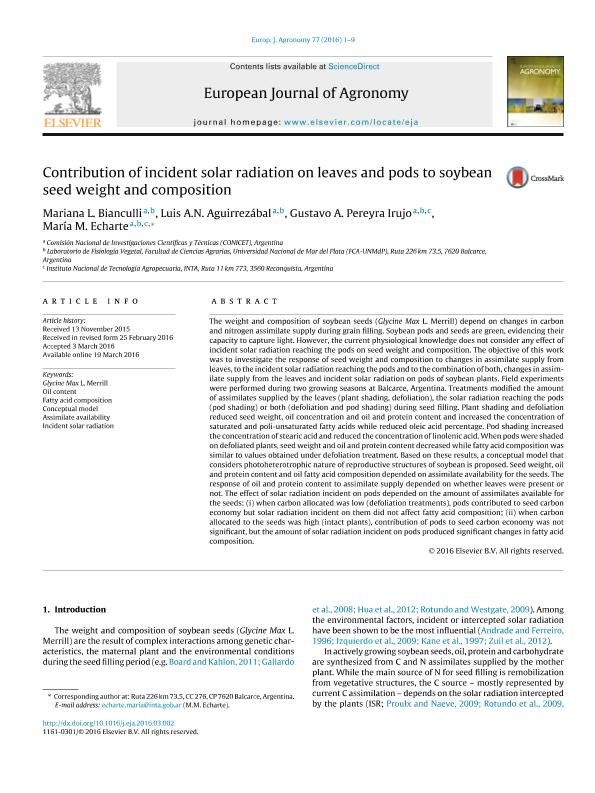Mostrar el registro sencillo del ítem
dc.contributor.author
Bianculli, Mariana Lujan

dc.contributor.author
Aguirrezábal, Luis Adolfo Nazareno

dc.contributor.author
Pereyra Irujo, Gustavo Adrian

dc.contributor.author
Echarte, Maria Mercedes

dc.date.available
2018-08-15T19:30:04Z
dc.date.issued
2016-07
dc.identifier.citation
Bianculli, Mariana Lujan; Aguirrezábal, Luis Adolfo Nazareno; Pereyra Irujo, Gustavo Adrian; Echarte, Maria Mercedes; Contribution of incident solar radiation on leaves and pods to soybean seed weight and composition; Elsevier Science; European Journal of Agronomy; 77; 7-2016; 1-9
dc.identifier.issn
1161-0301
dc.identifier.uri
http://hdl.handle.net/11336/55717
dc.description.abstract
The weight and composition of soybean seeds (Glycine Max L. Merrill) depend on changes in carbon and nitrogen assimilate supply during grain filling. Soybean pods and seeds are green, evidencing their capacity to capture light. However, the current physiological knowledge does not consider any effect of incident solar radiation reaching the pods on seed weight and composition. The objective of this work was to investigate the response of seed weight and composition to changes in assimilate supply from leaves, to the incident solar radiation reaching the pods and to the combination of both, changes in assimilate supply from the leaves and incident solar radiation on pods of soybean plants. Field experiments were performed during two growing seasons at Balcarce, Argentina. Treatments modified the amount of assimilates supplied by the leaves (plant shading, defoliation), the solar radiation reaching the pods (pod shading) or both (defoliation and pod shading) during seed filling. Plant shading and defoliation reduced seed weight, oil concentration and oil and protein content and increased the concentration of saturated and poli-unsaturated fatty acids while reduced oleic acid percentage. Pod shading increased the concentration of stearic acid and reduced the concentration of linolenic acid. When pods were shaded on defoliated plants, seed weight and oil and protein content decreased while fatty acid composition was similar to values obtained under defoliation treatment. Based on these results, a conceptual model that considers photoheterotrophic nature of reproductive structures of soybean is proposed. Seed weight, oil and protein content and oil fatty acid composition depended on assimilate availability for the seeds. The response of oil and protein content to assimilate supply depended on whether leaves were present or not. The effect of solar radiation incident on pods depended on the amount of assimilates available for the seeds: (i) when carbon allocated was low (defoliation treatments), pods contributed to seed carbon economy but solar radiation incident on them did not affect fatty acid composition; (ii) when carbon allocated to the seeds was high (intact plants), contribution of pods to seed carbon economy was not significant, but the amount of solar radiation incident on pods produced significant changes in fatty acid composition.
dc.format
application/pdf
dc.language.iso
eng
dc.publisher
Elsevier Science

dc.rights
info:eu-repo/semantics/openAccess
dc.rights.uri
https://creativecommons.org/licenses/by-nc-sa/2.5/ar/
dc.subject
Assimilate Availability
dc.subject
Conceptual Model
dc.subject
Fatty Acid Composition
dc.subject
Glycine Max L. Merrill
dc.subject
Incident Solar Radiation
dc.subject
Oil Content
dc.subject.classification
Agricultura

dc.subject.classification
Agricultura, Silvicultura y Pesca

dc.subject.classification
CIENCIAS AGRÍCOLAS

dc.title
Contribution of incident solar radiation on leaves and pods to soybean seed weight and composition
dc.type
info:eu-repo/semantics/article
dc.type
info:ar-repo/semantics/artículo
dc.type
info:eu-repo/semantics/publishedVersion
dc.date.updated
2018-08-15T14:23:23Z
dc.journal.volume
77
dc.journal.pagination
1-9
dc.journal.pais
Países Bajos

dc.journal.ciudad
Amsterdam
dc.description.fil
Fil: Bianculli, Mariana Lujan. Consejo Nacional de Investigaciones Científicas y Técnicas; Argentina. Universidad Nacional de Mar del Plata. Facultad de Ciencias Agrarias; Argentina
dc.description.fil
Fil: Aguirrezábal, Luis Adolfo Nazareno. Consejo Nacional de Investigaciones Científicas y Técnicas; Argentina. Universidad Nacional de Mar del Plata. Facultad de Ciencias Agrarias; Argentina
dc.description.fil
Fil: Pereyra Irujo, Gustavo Adrian. Consejo Nacional de Investigaciones Científicas y Técnicas; Argentina. Universidad Nacional de Mar del Plata. Facultad de Ciencias Agrarias; Argentina. Instituto Nacional de Tecnología Agropecuaria; Argentina
dc.description.fil
Fil: Echarte, Maria Mercedes. Consejo Nacional de Investigaciones Científicas y Técnicas; Argentina. Universidad Nacional de Mar del Plata. Facultad de Ciencias Agrarias; Argentina. Instituto Nacional de Tecnología Agropecuaria; Argentina
dc.journal.title
European Journal of Agronomy

dc.relation.alternativeid
info:eu-repo/semantics/altIdentifier/doi/https://dx.doi.org/10.1016/j.eja.2016.03.002
dc.relation.alternativeid
info:eu-repo/semantics/altIdentifier/url/https://www.sciencedirect.com/science/article/pii/S1161030116300478
Archivos asociados
